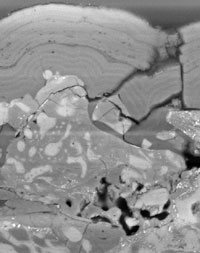Resorbable bioceramic coating has potential orthopaedic use
The coating was stable after being applied to a metallic substrate and subjected to conditions like those in the human b
 The
properties of two bioceramic coatings that German researchers recently studied
suggest they have potential for eventual use on metal orthopaedic implants as a
secondary, biologic form of fixation.
The
properties of two bioceramic coatings that German researchers recently studied
suggest they have potential for eventual use on metal orthopaedic implants as a
secondary, biologic form of fixation.
Researchers from two centers in Germany collaborated on the experiments and analyzed the chemical composition and other key properties of both materials. One of the materials is fully resorbable.
Both substances remained relatively stable after they were formed into tablets or granules that were plasma-sprayed onto metallic substrates. They were subsequently placed in simulated body fluid for approximately six months.
![Technological Advancement Awards [logo]](/~/media/images/news/print/orthopaedics-today-europe/2004/05_may/tech-award_300_125_1664.jpg) “Our investigation shows that the
fully resorbable coatings preferred,” said Anke Bernstein, PhD, who is at
the orthopaedic clinic of the State Medical University in Halle, Germany.
“Our investigation shows that the
fully resorbable coatings preferred,” said Anke Bernstein, PhD, who is at
the orthopaedic clinic of the State Medical University in Halle, Germany.
In April 2003, she and her colleagues collaborated with researchers at the Federal Institute for Material Research and Testing in Berlin on the project. For their work, Bernstein and her co-investigators received the Orthopaedics Today Technological Advancement Award at the Annual Meeting of the German Society for Orthopaedics and Orthopaedic Surgery (DGOOC) in Berlin.
Stable chemical composition
|
COURTESY OF ANKE BERNSTEIN |
The researchers tested two materials: GB14, an alkali-containing calcium phosphate, and S4, which is a glass ceramic that contains fluoroapatite and calcium zirconium phosphate.
“It has been shown that, due to its oxidizing atmosphere, the air plasma spray (APS) process represents a suitable coating method for the calcium phosphate ceramics that have been studied. Even in the presence of readily volatile alkalis in the GB14, the chemical composition remained virtually pristine. Similarly, the multicomponent injection powder S4 proved to be relatively stable,” they wrote in an abstract of their paper.
During the tests, GB14 and S4 were melted and crushed into granules (50 to 125 µm). Researchers applied them to substrates of roughened TiA16V4 targets (2 x 4 cm) using APS from a distance of 90 mm. Powder input was 5 l/min in a stream of argon.
The researchers initiated plasma coating using a PTM 1000 plant equipped with a Sulzer Metco F4MD electronic torch. “For a thickness layer of 120 to 180 µm, four plasma over-runnings were necessary,” Bernstein told Orthopaedics Today.
Tablets of both materials were also made in order to test changes in the materials under the same conditions, without having them undergo plasma spraying.
The coated substrates and tablets were then placed in simulated body fluid solution for 24 weeks. Researchers changed the solution and dried and weighed the tablets each week.
At 24 weeks, studies were conducted into the solubility, elastic modulus, porosity and thermal expansion of the materials using x-ray diffractometry. Researchers also used a special probe to conduct photo-optical and electron microscopy studies of the materials.
GB14 had a high alkali content in relation to its hydroxyapatite content. S4 “contains no alkali; however, [it has] remarkable quantities of zirconium,” she said.
For more information:
- Gildenhaar R, Berger G, Bernstein A, et al. New bioceramics for implant coatings. Presented at the Annual Meeting of the German Society for Orthopaedics and Orthopaedic Surgery. Nov. 13-16, 2003. Berlin.

